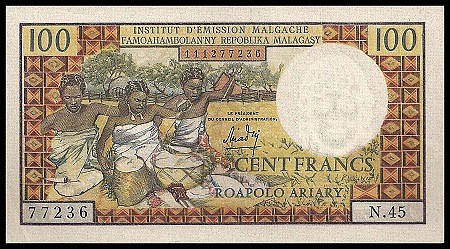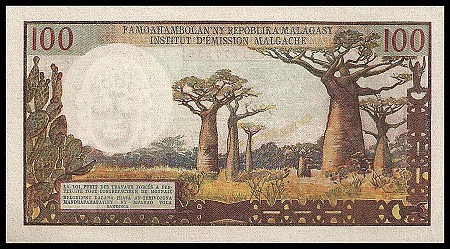MADAGASCAR
Baobab Tree

There exists in this world a gargantuan tree that can grow to a height of 100 feet, and have a 35 foot diameter trunk. When fully grown, this tree creates its own ecosystem based solely on its presence. Legends surround the trees origin, age, demise and magical powers. It is very resilient, but when it does die, it falls over with a mighty thud and disintegrates so quickly, that it is rumored to disappear overnight.
This is the mighty Baobab.
The Baobab tree can be found in it’s majesty in Continental Africa, Madagascar and also Australia, where they are also called “Boabs”. Their immense growth is due to the tree’s swollen trunks acting as water reservoirs in which mature trees can hold over 31,000 U.S. gallons of water. This water storage system enables the trees to survive the tough drought cycles that are found throughout its habitat. After a rainfall, water can be obtained in large open splits in the branches. They can also provide water to those in need if the roots are tapped.
This is the largest succulent in the world, and there are eight species of Baobab, six of which are native to Madagascar, with one species each native to mainland Africa and Australia. The trees are deciduous, and lose their leaves during the dry season. The Baobab is also known as: Monkey Bread Tree, Cream of tartar tree, lemonade tree, boab, bottle tree, God’s Thumb, and the upside-down tree.
Unlike other trees, the Baobabs do not produce any growth rings. This peculiar fact has led to wild speculation about the age of some trees, which are estimated to be from four to six thousand of years in age. Only a few other trees, the Bristle-Cone Pine, Giant Sequoia and Japanese cedar can come close to this timeline. At first glance of these impressive trees one can easily believe that they could very well live so long. Yet amazingly, these massive trees are cultivated and used extensively in Bonsai planters.
The Baobab has long been used by humans as a food source. The leaves, known as “kuka” can be eaten fresh or dried. The bark can be made into a tea and a beer, but it is said that it is most definitely an ‘acquired’ taste.
The fruit is also known as “monkey’s bread” and is found inside of a large hard nut covered by dark yellow hairs, and is reported to exceed both the content of vitamin C in oranges and also of calcium found in cow milk. Inside the nut is found a dry, powdery material surrounding the seeds. Mixed with water, the powder can produce a type of drink which is sometimes used to cure fevers. The seeds can be used to produce an oil, and can be brewed, but they are not typically eaten which ensures their dispersion by mankind and primates that will eat the rest of the fruit. This fruit has recently been approved for consumption by the European Community. The fruit was also once used in the making of Tartar Sauce. Baobabs that have been grown from a seed in the natural climates can take as long as ten years to produce fruit. But modern horticulturists can grow trees that produce fruit in as short a time as two years.
The trees can hollow out and their girth can be used as shelter. In Derby, Western Australia there is a tree known as the “Prison Tree” that was actually used to detain aborigines during the late 19th century. Other uses have included storage, small homes, stores, and in South Africa, there’s even one tree that’s been converted into a bar.
The tree blossoms between May and August over a single night and last only 24 hours, which is a remarkably short time for the pollination to be done by fruit bats. The flowers are white and very aromatic which makes it easier for the fruit bats to find.
Legends of the Baobab tree abound. One of my favorites is that when the world was young, the Baobab wanted to be the most beautiful tree in the world. When the Baobab saw that it was not the most beautiful tree it became angry and buried its canopy into the ground, and left the roots at the top.
Another favorite legend is that when God planted the mighty Baobab, the tree started to walk away. Each time God would pull it back and replant it, the Baobab would start walking off again. So God finally pulled it up and planted it upside down to keep the tree from wandering.
The massive Baobab is featured on many African banknotes, but none of them more prominently than this 100 Francs from Madagascar.

